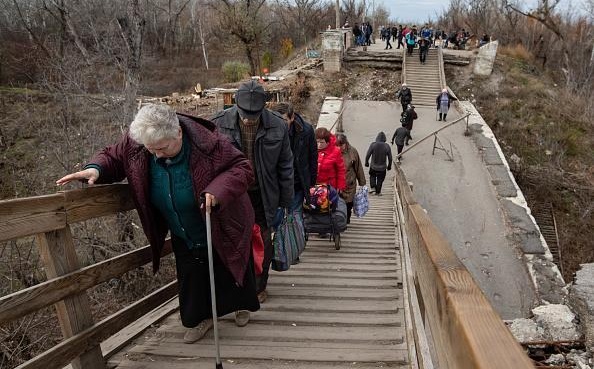People cross the broken bridge at the Stanytsia Luhanska checkpoint in east Ukraine, November 6, 2018 (Stanislav Krasilnikov/TASS)
After conflict broke out in the Donbass region of eastern Ukraine in 2014, Viktoria Vasilevska and her family moved west to the capital of Kyiv.
Viktoria hoped that aid could put them on the path to a settled life, but “when I applied to many different agencies for help, [I] didn’t hear back from any of them”.
Perhaps the reason was the strain on resources as many others enter the city seeking refuge. Perhaps it was the negative representation of internally displaced persons as “burdens”. Perhaps it was the lack of clarity over the rights of IDPs.
Whatever the reason, the story of Viktoria and her family is that of an estimated 1.4 million IDPs, at risk of being no more than a statistic as headlines focus on Russia’s threat to invade Ukraine and seize the Donbass where Viktoria once lived.
“Between A Rock and A Hard Place”
The conflict since 2013 across Ukraine defies easy definition. The political and economic conditions that led to the overthrow of pro-Russian President Viktor Yanukovych in 2014 intersect with the local dynamics in the east, including the Donbass, and Russia’s annexation of Crimea and support of separatists of the “Donetsk People’s Republic” and the “Luhansk People’s Republic”.
In 2014, about 300 people lived in the village of Nevelske, 15 miles from the city of Donetsk. As conflict surged, the population plummeted to just 45. What was once a sustainable community is now an area without adequate electricity or water pumps.
Aid to Nevelske, from the International Committee of the Red Cross and Czech charity People in Need, was limited. One resident said there was little chance of a future with the Ukrainian Government, as it looked to the West and NATO. He asserted, “Russia will help.”
But Moscow’s “help” has only fuelled the instability and displacement.
Those who flee enter limbo. Internally displaced persons cannot be classified as “refugees”, with the corresponding attention to their plight and legal rights, as they have not crossed an internationally-recognized border. This does nothing to mitigate risk, as Russia stepping up the threat to lives and homes.
Recognition is needed to ensure suitable assistance. However, with the internal and external pressure on the Ukrainian Government, that prospect is distant. As one resident of Nevelske, Vladimir, summarized, “We are between a rock and a hard place.”
As of December 31, the official number of IDPs in Ukraine was 734,000, with mounting pressure to deliver aid and resources. Two weeks ago, the Ukrainian Government — in cooperation with other countries at the Diia Summit — announced new services to ensure that “internally displaced persons can submit electronic applications…to prolong…monthly targeted assistance provided to cover their living expenses, including housing and communal services”.
However, the renewed focus on issues surrounding IDPs in the region is accompanied by conflict and uncertainty, further stoking the pressure on more residents to flee. The rising number means that demand for assistance cannot always be met. Those who do gain access may be subjected to long waiting periods.
Many hold out for a better future but endure the present. In Kyiv, Ismail Ramazanov, a Muslim Tatar, talks about his forced departure when Russia occupied Crimea in 2014.
Working to raise awareness about those facing life in Crimea under Russian occupation, he says he will not flee again, learning to handle a gun and how to administer medicine.
“We’ve got nowhere else to run,” he says. “I won’t leave here.”


Thank you Sarah. I too think often the people on the ground, the everyday person and their situation is forgotten. Too often we focus on the leaders, their agenda and connections and we forget about how this impacts people on the ground on both sides. Like most conflicts there are a number of complexities and few circumstances are purely black and white. In this instance individuals/communities on both sides are being impacted whether they are pro-Ukraine or pro-Russia. I believe that the media often only presents one point of you with one agenda. Since writing this piece earlier in the year and seeing how the conflict in Russia and Ukraine has changed I believe that media representation on both sides is not being reflected to the public meaning that the stories of individuals on the ground are also not being told on all fronts. No matter your views on this conflict, which may differ, mould or alter as it continues, the lives of civilians should be considered with their concerns and situations told on both sides in an objective manner.
Insightful and eloquently written article. Too often the media only covers the top level politics. Thanks for giving a voice citizens that are on the ground and living through this nightmare.